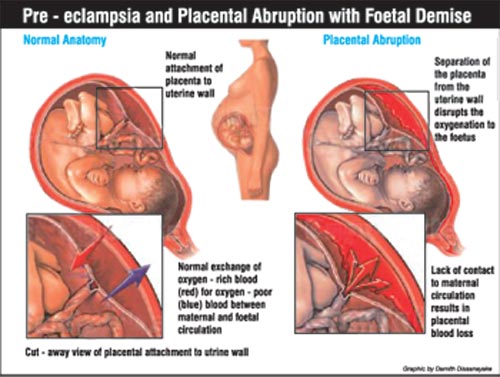
Beware of pregnancy - induced hypertensionMiriam was in the seventh month of pregnancy expecting to deliver her first child. With her husband out of town, she hadn't visited the clinic in two months, assuming that the swelling on her feet and face and the general discomfort were normal in her condition. She further attributed the consistent headache and blurring of vision to sleepless nights.
A concerned neighbour insisted that she see her doctor who promptly had her admitted to the hospital. She was rushed to the intensive care unit and her baby was delivered by Caesarean section. Both mother and baby were saved. However, another couple of hours and the young mother would have had fits and gone into a coma as she was in an advanced stage of Pre-eclampsia, according to Consultant Obstetrician and Gynaecologist, Dr. Deepal S. Weerasekera. What is Pre-eclampsia? Preeclampsia is pregnancy-induced hypertension. This condition is common throughout the world but more frequent in developing countries. Defined by high blood pressure and excess protein in the urine usually after the fifth month of pregnancy, the condition is more often seen among women in the lower socio-economic group. Causes: Medical researchers are yet to determine the cause of Pre-eclampsia. However, it has been found to be common among those with a history of previous Pre-eclampsia, gestational diabetes, obesity and renal/kidney problems. It is generally seen in the first pregnancy and the 5th and subsequent pregnancies and is less common in the 2nd, 3rd and 4th pregnancies. Teenagers and those conceiving after 35 years of age are also at high risk of developing the condition. Symptoms: Signs that can develop gradually or all of a sudden are elevated blood pressure, upper abdominal pain, breathlessness, unusual headaches, significant swelling on feet and face, nausea or vomiting, dizziness, sudden weight gain, and blurring of vision. Further, a urine test would reveal excess protein. At times, Pre-eclampsia is symptom-less. "This could be dangerous because if the blood pressure rises above a certain level, the mother could develop fits or seizures and go into eclampsia," Dr. Weerasekera warns. It is important to note that swelling alone cannot be considered a sign of Pre-eclampsia as it also occurs in normal pregnancies. Treatment: When Pre-eclampsia is diagnosed in its early stages, a mother is advised bed rest and her BP is monitored closely. However if the disease progresses, the doctor would be left without a choice but to induce labour or deliver by Caesarean, regardless of whether the baby has matured to full term or not. The blood pressure would then return to normal within 2-3 days. Complications Pre-eclampsia can affect the arteries carrying blood to the placenta. When this happens the foetus receives less oxygen and nutrition, resulting in slow growth, low birth weight, pre-maturity or stillbirth. Pre-eclampsia also increases the risk of the placenta separating from the inner wall of the uterus before delivery (abruption). This can cause uncontrollable bleeding and be life-threatening for both mother and baby. Another complication is Eclampsia (Pre-eclampsia plus seizures) that happens when Pre-eclampsia is uncontrolled. This is associated with maternal mortality. It can cause choking during fits, bleeding in the brain, renal failure, and permanent damage to vital organs of the body including the brain, liver and kidney. Left untreated it can bring about a coma, brain damage and death for both mother and baby. In certain cases, a mother can develop the HELLP Syndrome, a terminal stage of the disease that affects the liver and destroys red blood cells, leading to renal failure. Importance of anti-natal checks: "Pre-eclampsia is one of the commonest causes of maternal deaths in the country," says Dr. Weerasekera. As Pre-eclampsia can occur without warning, pregnant women are advised to visit the clinic every month during the first six months, once in two weeks in the 7th and 8th months and every week during the last month. Each visit should include a BP check amongst other tests. "It is a primary function of an anti-natal clinic," Dr. Weerasekera adds. Prevention: Pre-eclampsia can be prevented through proper nutrition, spacing of pregnancies and limiting the number of children to two or three. Women are also advised proper rest and regular anti-natal checks. With the aim to improving maternal health, the Health Ministry currently runs a programme to improve facilities in rural hospital maternity units to manage severe cases. Increased importance is placed on the role of the midwife who makes field visits, identifies pregnant mothers, visits their homes, conducts urine tests and motivates them to attend the anti-natal clinic so that proper care is given as BP checks and urine tests are effective screening tools for Pre-eclampsia. |
|| Front
Page | News | Editorial | Columns | Sports | Plus | Financial
Times | International | Mirror | TV
Times | Funday
Times | Medi Scene || |
| |
Copyright
2007 Wijeya
Newspapers Ltd.Colombo. Sri Lanka. |
